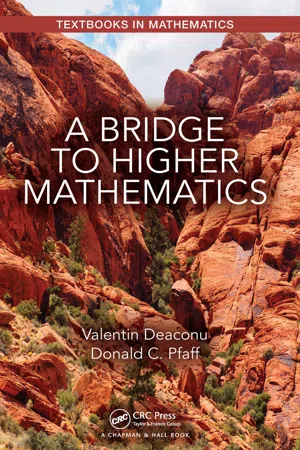
- 204 pages
- English
- ePUB (mobile friendly)
- Available on iOS & Android
A Bridge to Higher Mathematics
About this book
A Bridge to Higher Mathematics is more than simply another book to aid the transition to advanced mathematics. The authors intend to assist students in developing a deeper understanding of mathematics and mathematical thought.
The only way to understand mathematics is by doing mathematics. The reader will learn the language of axioms and theorems and will write convincing and cogent proofs using quantifiers. Students will solve many puzzles and encounter some mysteries and challenging problems.
The emphasis is on proof. To progress towards mathematical maturity, it is necessary to be trained in two aspects: the ability to read and understand a proof and the ability to write a proof.
The journey begins with elements of logic and techniques of proof, then with elementary set theory, relations and functions. Peano axioms for positive integers and for natural numbers follow, in particular mathematical and other forms of induction. Next is the construction of integers including some elementary number theory. The notions of finite and infinite sets, cardinality of counting techniques and combinatorics illustrate more techniques of proof.
For more advanced readers, the text concludes with sets of rational numbers, the set of reals and the set of complex numbers. Topics, like Zorn's lemma and the axiom of choice are included. More challenging problems are marked with a star.
All these materials are optional, depending on the instructor and the goals of the course.
Frequently asked questions
- Essential is ideal for learners and professionals who enjoy exploring a wide range of subjects. Access the Essential Library with 800,000+ trusted titles and best-sellers across business, personal growth, and the humanities. Includes unlimited reading time and Standard Read Aloud voice.
- Complete: Perfect for advanced learners and researchers needing full, unrestricted access. Unlock 1.4M+ books across hundreds of subjects, including academic and specialized titles. The Complete Plan also includes advanced features like Premium Read Aloud and Research Assistant.
Please note we cannot support devices running on iOS 13 and Android 7 or earlier. Learn more about using the app.
Information
1
Elements of logic
1.1 True and false statements
1.2 Logical connectives and truth tables
P | ¬P |
T | F |
F | T |
Table of contents
- Cover
- Half Title
- Title Page
- Copyright Page
- Contents
- Preface
- 1 Elements of logic
- 2 Proofs: Structures and strategies
- 3 Elementary theory of sets
- 4 Functions
- 5 Relations
- 6 Axiomatic theory of positive integers
- 7 Elementary number theory
- 8 Cardinality: Finite sets, infinite sets
- 9 Counting techniques and combinatorics
- 10 The construction of integers and rationals
- 11 The construction of real and complex numbers
- Bibliography
- Answers to select exercises
- Index